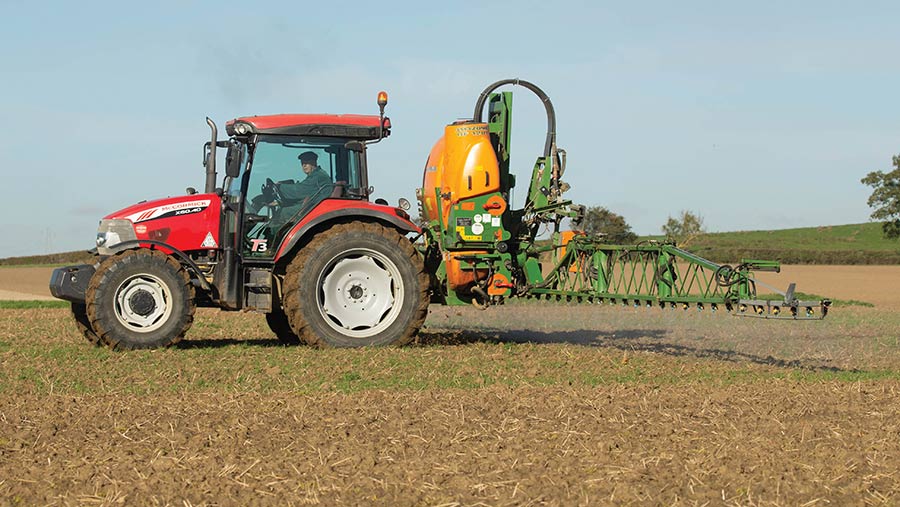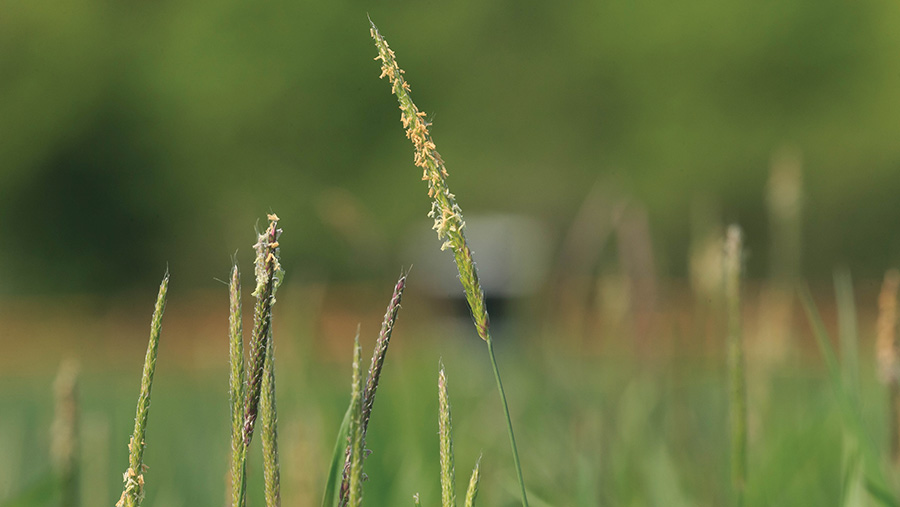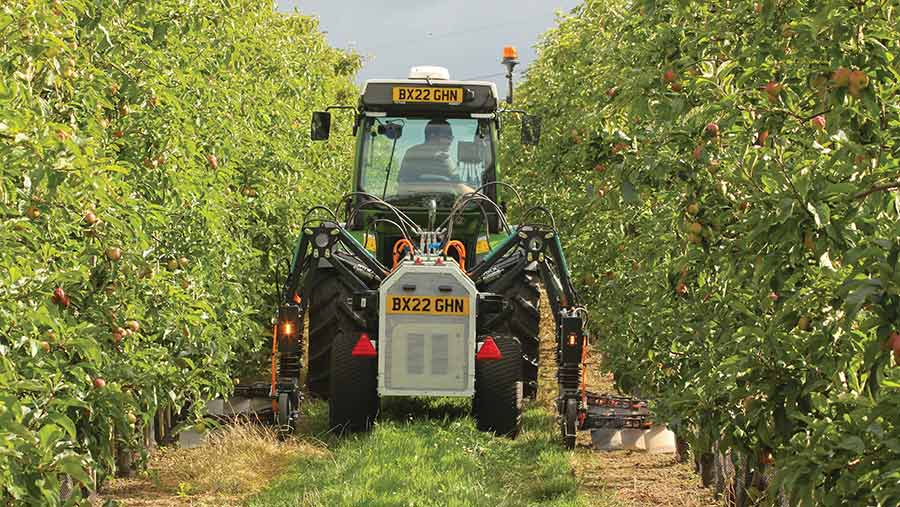Natural bioherbicides show promise in tackling weeds
 © Tim Scrivener
© Tim Scrivener Could mint extracts be the secret ingredient to tackling resistant weeds, such as blackgrass and Italian ryegrass? Could they even be a glyphosate replacement?
That’s what a US-based start-up company, Harpe Bioherbicide Solutions, is hoping as it develops natural bioherbicides based on plant extracts, primarily from the menthus or mint family.
See also: Video: Mechanical hoes offer solution as herbicide resistance builds
Harpe’s co-founder, Dr Chad Brommer, reviewed hundreds of plant extracts for potential herbicidal compounds, but narrowed the selection to those from mint, dill and caraway.
These are being formulated into non-selective herbicides that can be sprayed using traditional farm equipment or drones.
Research has shown that in the right combination and mixes, these essential oil compounds, which are extracted from the leaves by steam distillation, cause plant cell walls to leak.
Daniel Pepitone, chief operating officer for Harpe, explains: “That means when you make an application, whether pre-emergence or post-emergence, the cellular membranes can no longer function.”
Post-emergence, that means plants will wilt as the cells cannot retain water, photosynthesis stops as the chloroplast membranes leak, while energy production ceases when mitochondria walls are attacked.
“The plant stops functioning and dies,” Daniel says. “By having multiple points of attack at the same time, we’re throwing a lot at the plant that it cannot recover from.”

© Tim Scrivener
Pre-emergence
When used pre-emergence, the compounds disrupt the cellular communication required for germination, slow cell division, and stop germination and root and shoot emergence.
“Most pre-emergence products today needs the weed seeds to swell and germinate before coming into contact with the herbicide,” Daniel says.
“We don’t need to wait for the seed to germinate. We prevent it – the product just needs to come into contact with the seed.”
The multiple modes of action, he says, should also reduce the risk of resistance developing.
About 15 unique formulations derived from natural and nature-identical sources are being developed as solo products, which will be suitable for both conventional and organic markets. A further 32 pre-mixed formulations combine the extracts with existing herbicides such as glyphosate, pendimethalin, metribuzin and glufosinate.
Daniel says: “You will need more Harpe [bioherbicide] when it is doing the work alone, so we don’t see it as an either/or for our chemistry.”
The extracts can be used in pre-emergence markets, where the products prevent germination of and control small-seeded broad-leaf weeds and grassweeds in the top 2cm of the soil, including resistant blackgrass and Italian ryegrass.
UK trials
“In UK trials, as long as we get good coverage, we’re achieving 85%-plus control of blackgrass,” Daniel says.
“Currently, we’re trying to fine-tune the formulation, so we get best coverage and consistent outcomes, while lowering the actives needed to do that.”
The product does not move through the soil profile, meaning that crop seeds planted to the correct depth are unaffected. This is similar to how current pre-emergence herbicides, such as flufenacet and cinmethylin, achieve crop safety.
Harpe also expects its products to be used in non-selective herbicide markets where glyphosate is currently dominant, including pre-drilling stubble clean-up and pre-harvest desiccation applications, although it is not as systemic as glyphosate.
Another potential use is in combination with herbicide-tolerant crops. The firm recently signed a licence agreement with Corteva Agriscience to use Crispr-Cas 9 gene editing technology to develop such crops with St Louis, Missouri-based Solis Agrosciences.
“That means in future we’ll have the ability to spray Harpe formulations over the top of crops and not injure them,” Daniel says.
“Gene editing is the most likely path to do that, which will expand the opportunity for growers and to stack traits that are available today in herbicide-tolerant crops.”
The products are likely to be introduced first in the US, where some of the natural plant extracts are classified as minimum risk under Section 25(b) of the Federal Insecticide, Fungicide and Rodenticide Act (Fifra), and so are exempt from regulations on efficacy and toxicity.
“We’re working through our understanding of other key markets because registration is different,” Daniel says.
“But these products are well-known compounds that are consumed and used by people every day, so a lot of information exists. We hope to be able to expedite registration – I would hope it would be less than five years.”
That might not be under the Harpe Bioherbicides banner, though. “Our end goal is not to commercialise ourselves, but to exit to a partner, such as one of the leading crop protection companies.
“They have all the things we don’t as a start-up – marketing, distribution and production on a global scale.”
Electrical weed control machinery in development

RootWave’s electric weeder for use in vineyards and orchards © Adam Clarke
Using electricity as the primary “mode of action” is becoming increasingly practical as technology develops.
German company crop.zone has co-developed with John Deere a 24m version of its system, which sprays a conductive liquid onto the target, lowering the leaf surface’s resistance to an electrical current applied through special applicators.
In previous systems the spray boom was attached to the front of the tractor. In the new John Deere version it is integrated into an existing John Deere trailed sprayer, says Dirk Vandenhirtz, chief executive of crop.zone.
“You spray and apply at the same time,” he says. “You drive at 6km/h – one pass is enough so you can do about 40ha/hour. We only use 26kWh/ha, which is less than an electrical vehicle would use on a 100km journey.”
The system is targeted at non-selective burndown markets, such as desiccation of crops including potatoes, cereals, chickpeas and cotton.
A British company, RootWave, has also developed an electric weeder, for use in vineyards and orchards.
Developed as a follow-up to a hand-held spot weeder which used 50Hz frequency, the tractor-powered machine uses a higher frequency waveform of 18kHz, explains Tom Archer, head of marketing for RootWave.
“50Hz is the same as our domestic power supply and can be a lethal form of electricity, whereas 18kHz and above is a higher frequency waveform that is safer than 50Hz and DC. However, it does still kill weeds.”
Used for weed control, electricity is similar to glyphosate in that it is systemic, he explains.
“We have to make contact with the leaf of the plant with our electrodes, and electricity flows through the plant and into the roots, gets converted to heat energy and near-instantaneously kills the plant.”
The tractor-mounted and powered machine has three treatment electrodes on either side, delivering up to 10kW each.
“These electrode arms are flexible to be able to treat 1.8m to 4m wide rows, which is important as there can be huge variability in row widths on fruit farms,” Tom says.
Targeting new modes of action
MoA Technology, a start-up spun out of University of Oxford research, has developed a high-throughput platform that uses miniaturised plants to help identify new compounds with potential herbicidal activity and novel modes of action.
“We are focused on addressing herbicide resistance,” explains Dr Virginia Corless, MoA Technology’s chief executive.
“And there is broad consensus that one of the best ways is to discover new herbicides that work in new ways with new modes of action, such that there is no evolved resistance in weed populations.
“What is special about our discovery engine is by working with these miniaturised plants, we’re able to identify symptoms that tell us with a high degree of specificity about the mode of action of the compounds we are testing.”
Traditional screens use slightly larger plants in glasshouses when symptoms become more generic, she notes.
That often means new discoveries turn out to have existing modes of action, whereas MoA’s platform finds varied and distinctive symptoms which can identify novel modes of action at the first step.
“Our pipeline is filled with molecules, synthetic and natural, that meet the criteria of having both herbicidal efficacy and novel modes of action,” she says.
So far, nothing in that pipeline has made the registration process, she says. “That’s always a multiyear process but we are pushing towards that point as fast as possible.”